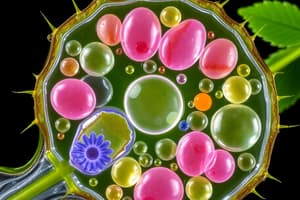Podcast
Questions and Answers
What is the primary composition of the cell wall in plant cells?
What is the primary composition of the cell wall in plant cells?
What is the main function of chloroplasts in plant cells?
What is the main function of chloroplasts in plant cells?
Which organelle is responsible for storing water, nutrients, and waste products in plant cells?
Which organelle is responsible for storing water, nutrients, and waste products in plant cells?
What are plasmodesmata in the context of plant cells?
What are plasmodesmata in the context of plant cells?
Signup and view all the answers
Which layer of the cell wall provides flexibility in plant cells?
Which layer of the cell wall provides flexibility in plant cells?
Signup and view all the answers
What role does the vacuole play in plant cells?
What role does the vacuole play in plant cells?
Signup and view all the answers
Where does the light absorption occur in chloroplasts?
Where does the light absorption occur in chloroplasts?
Signup and view all the answers
Which substance is primarily stored in the vacuole?
Which substance is primarily stored in the vacuole?
Signup and view all the answers
What is the primary function of chlorophyll in chloroplasts?
What is the primary function of chlorophyll in chloroplasts?
Signup and view all the answers
What is the function of the stroma in chloroplasts?
What is the function of the stroma in chloroplasts?
Signup and view all the answers
Flashcards
Vacuole
Vacuole
An organelle that maintains turgor pressure and regulates water balance in a cell.
Turgor pressure
Turgor pressure
The pressure of cell contents against the cell wall, essential for plant rigidity.
Chloroplast
Chloroplast
The organelle in plant cells where photosynthesis occurs, converting light energy to chemical energy.
Chlorophyll
Chlorophyll
Signup and view all the flashcards
Thylakoid
Thylakoid
Signup and view all the flashcards
Plant Cell
Plant Cell
Signup and view all the flashcards
Cell Wall
Cell Wall
Signup and view all the flashcards
Central Vacuole
Central Vacuole
Signup and view all the flashcards
Endoplasmic Reticulum (ER)
Endoplasmic Reticulum (ER)
Signup and view all the flashcards
Study Notes
Plant Cell Structure
- Plant cells are eukaryotic cells, distinct from animal cells due to structures for photosynthesis and support.
- Plant cells are generally larger than animal cells.
- The cell wall, a rigid outer layer, provides structural support and protection, primarily composed of cellulose.
- The cell membrane, a thin layer, controls material passage into and out of the cell.
- A large central vacuole, occupying much of the cell's interior, stores water, nutrients, and waste.
- Chloroplasts, containing chlorophyll, are essential for photosynthesis, capturing light energy to create glucose.
- Mitochondria, like in animal cells, are the energy producers, responsible for cellular respiration.
- The nucleus houses the cell's DNA, organized into chromosomes, acting as the control center.
- Ribosomes, involved in protein synthesis, are present in the cytoplasm, either freely floating or attached to the endoplasmic reticulum (ER).
- The endoplasmic reticulum (ER) is a network of membranes involved in protein and lipid synthesis. Smooth ER synthesizes lipids, while rough ER, with attached ribosomes, synthesizes proteins.
- The Golgi apparatus processes, modifies, and packages proteins and lipids for transport.
- Plastids, such as amyloplasts (starch storage) and chromoplasts (pigment storage), contribute to plant color and function.
Plant Cell Wall
- The cell wall is a rigid layer surrounding the cell membrane, crucial for structural support and shape maintenance.
- Primarily composed of cellulose, a complex carbohydrate arranged as a network of strands.
- Layers include the primary cell wall (flexible), secondary cell wall (strength), and middle lamella (sticky substance connecting adjacent cells).
- The cell wall facilitates interactions between neighboring plant cells. Plasmodesmata, channels in the cell wall, allow communication and material exchange between adjacent cells.
Plant Vacuole
- The central vacuole is a large, membrane-bound organelle, taking up a significant portion of the plant cell's volume.
- It maintains turgor pressure (cell content pressure against the wall).
- Regulates water balance through selective uptake and release of water.
- Stores water, nutrients, waste products, pigments, and enzymes.
- Critical for cell growth and development.
Plant Chloroplasts
- Chloroplasts are the sites of photosynthesis within plant cells.
- Double-membrane bound organelles.
- Inner membrane contains thylakoid sacs, where chlorophyll resides, absorbing light energy, primarily red and blue light.
- Grana are stacks of thylakoid sacs.
- Stroma is the fluid surrounding thylakoids, where the dark reaction of photosynthesis occurs.
- Chloroplasts convert light energy to chemical energy (glucose), used in respiration.
Studying That Suits You
Use AI to generate personalized quizzes and flashcards to suit your learning preferences.
Description
Explore the fascinating structures that make up plant cells, distinct from animal cells. Learn about the roles of the cell wall, chloroplasts, vacuole, and other organelles essential for functions such as photosynthesis and energy production. This quiz will test your understanding of how these components work together to support plant life.




